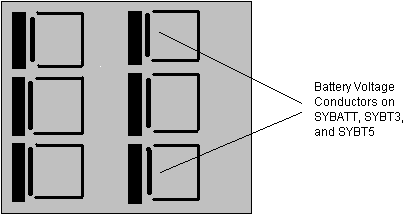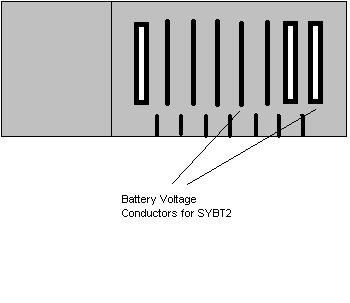Issue
I need to measure the battery voltage from an individual Symmetra battery module; what is the procedure?
Product Line
Symmetra Power Array
Symmetra RM
Symmetra LX
Environment
All serial ranges
Cause
It may be necessary to measure the voltage of a battery during troubleshooting of certain issues.
Resolution
Note: It is recommended that only qualified electrical personnel measure the battery voltage from an individual module.
The battery module must first be removed from the Symmetra UPS system. The removal procedure will differ depending upon the Symmetra UPS system.
On the rear of the SYBATT, SYBT3 and the SYBT5 battery module you will see the battery connector as shown below. The following diagram shows where the battery voltage can be measured for the SYBATT, SYBT3 and the SYBT5 by attaching each probe of your voltmeter to the appropriate conductors.

To measure the battery voltage of the Symmetra 2-6kVA RM battery modules, SYBT2, the battery first needs to be removed. This is done by first unscrewing both retaining screws in the upper corners of the battery module. The module can then be pulled 2/3 of the way out. Two black buttons will appear on the top of the battery module that need to be depressed to fully remove the module (it may be necessary to remove the plastic bezel from the level above the battery being removed in order to see these buttons). On the rear of the battery module you'll see the battery connector as shown below:

Notice that the far right connection is a female connection and the 4th connection from the right is a male connection. The battery voltage can be measured by attaching each probe of the voltmeter to these conductors.
In any case, the charged battery voltage of all 4 of these battery modules should be approximately 137 VDC at float charge. If the voltage is below approximately 95 VDC, the battery module may not be recognized in the system and may not allow the UPS to come out of bypass operation.
I need to measure the battery voltage from an individual Symmetra battery module; what is the procedure?
Product Line
Symmetra Power Array
Symmetra RM
Symmetra LX
Environment
All serial ranges
Cause
It may be necessary to measure the voltage of a battery during troubleshooting of certain issues.
Resolution
Note: It is recommended that only qualified electrical personnel measure the battery voltage from an individual module.
The battery module must first be removed from the Symmetra UPS system. The removal procedure will differ depending upon the Symmetra UPS system.
On the rear of the SYBATT, SYBT3 and the SYBT5 battery module you will see the battery connector as shown below. The following diagram shows where the battery voltage can be measured for the SYBATT, SYBT3 and the SYBT5 by attaching each probe of your voltmeter to the appropriate conductors.
To measure the battery voltage of the Symmetra 2-6kVA RM battery modules, SYBT2, the battery first needs to be removed. This is done by first unscrewing both retaining screws in the upper corners of the battery module. The module can then be pulled 2/3 of the way out. Two black buttons will appear on the top of the battery module that need to be depressed to fully remove the module (it may be necessary to remove the plastic bezel from the level above the battery being removed in order to see these buttons). On the rear of the battery module you'll see the battery connector as shown below:
Notice that the far right connection is a female connection and the 4th connection from the right is a male connection. The battery voltage can be measured by attaching each probe of the voltmeter to these conductors.
In any case, the charged battery voltage of all 4 of these battery modules should be approximately 137 VDC at float charge. If the voltage is below approximately 95 VDC, the battery module may not be recognized in the system and may not allow the UPS to come out of bypass operation.
發佈於: 施耐德電機Taiwan



